Applying Healthcare Informatics to Improve Patient Experience
VerifiedAdded on 2023/04/06
|6
|1124
|411
Report
AI Summary
This report discusses the application of healthcare informatics to improve patient care, focusing on a case scenario involving a pregnant woman's experience with healthcare services. It identifies issues such as appointment scheduling difficulties, long wait times, and impersonal survey methods. The report proposes implementing Information Communication Technologies (ICTs) like telehealth, online genetic counseling, and electronic health records to address these issues, aiming to enhance patient engagement, safety, and satisfaction. It also acknowledges potential challenges such as high implementation costs and clinician resistance, while emphasizing the overall benefits of ICTs in streamlining healthcare processes and improving patient outcomes. Desklib offers a wealth of resources, including solved assignments and past papers, to support students in their studies.

Running head: HEALTHCARE
Health informatics
Name of the Student
Name of the University
Author Note
Health informatics
Name of the Student
Name of the University
Author Note
Paraphrase This Document
Need a fresh take? Get an instant paraphrase of this document with our AI Paraphraser
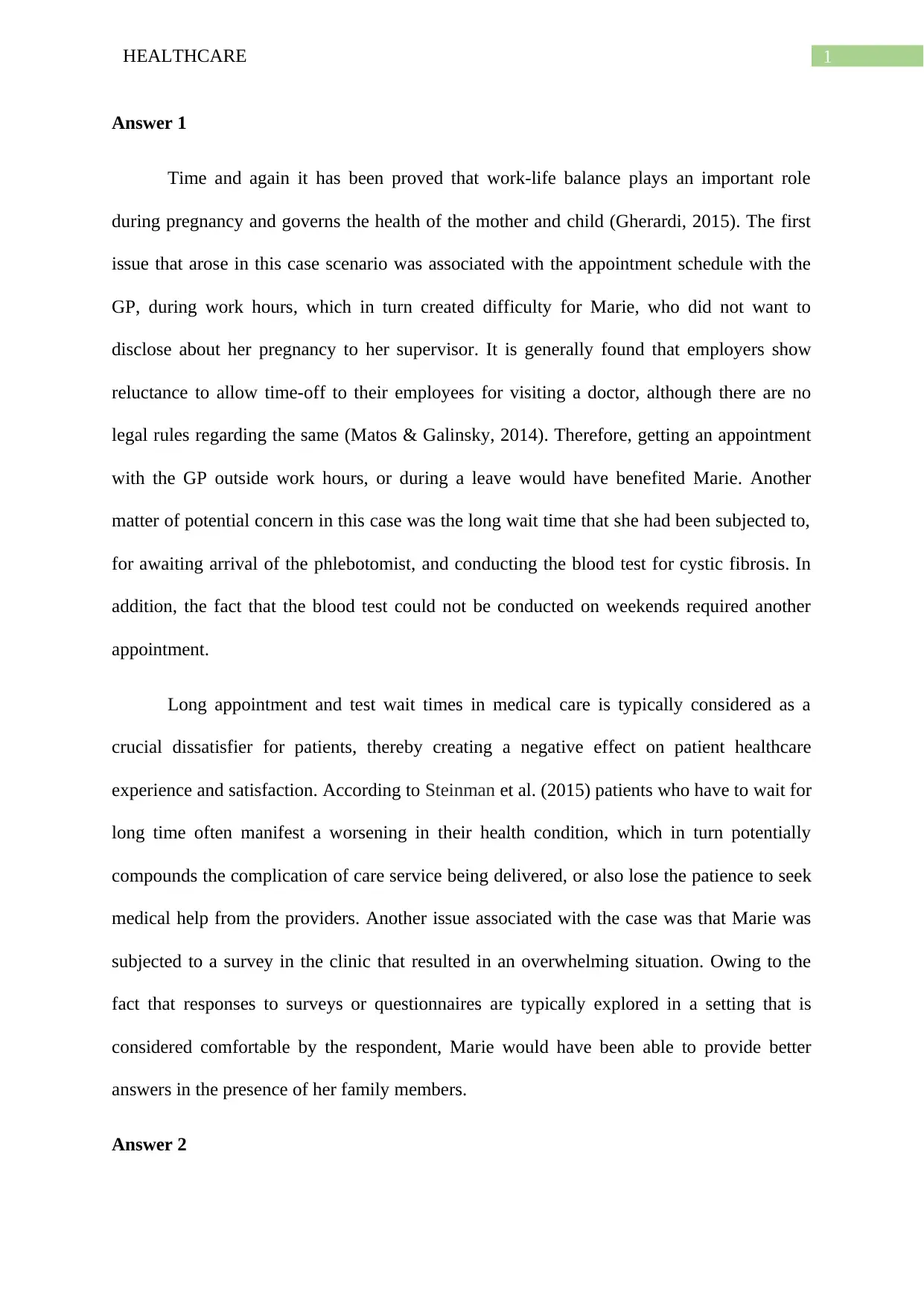
1HEALTHCARE
Answer 1
Time and again it has been proved that work-life balance plays an important role
during pregnancy and governs the health of the mother and child (Gherardi, 2015). The first
issue that arose in this case scenario was associated with the appointment schedule with the
GP, during work hours, which in turn created difficulty for Marie, who did not want to
disclose about her pregnancy to her supervisor. It is generally found that employers show
reluctance to allow time-off to their employees for visiting a doctor, although there are no
legal rules regarding the same (Matos & Galinsky, 2014). Therefore, getting an appointment
with the GP outside work hours, or during a leave would have benefited Marie. Another
matter of potential concern in this case was the long wait time that she had been subjected to,
for awaiting arrival of the phlebotomist, and conducting the blood test for cystic fibrosis. In
addition, the fact that the blood test could not be conducted on weekends required another
appointment.
Long appointment and test wait times in medical care is typically considered as a
crucial dissatisfier for patients, thereby creating a negative effect on patient healthcare
experience and satisfaction. According to Steinman et al. (2015) patients who have to wait for
long time often manifest a worsening in their health condition, which in turn potentially
compounds the complication of care service being delivered, or also lose the patience to seek
medical help from the providers. Another issue associated with the case was that Marie was
subjected to a survey in the clinic that resulted in an overwhelming situation. Owing to the
fact that responses to surveys or questionnaires are typically explored in a setting that is
considered comfortable by the respondent, Marie would have been able to provide better
answers in the presence of her family members.
Answer 2
Answer 1
Time and again it has been proved that work-life balance plays an important role
during pregnancy and governs the health of the mother and child (Gherardi, 2015). The first
issue that arose in this case scenario was associated with the appointment schedule with the
GP, during work hours, which in turn created difficulty for Marie, who did not want to
disclose about her pregnancy to her supervisor. It is generally found that employers show
reluctance to allow time-off to their employees for visiting a doctor, although there are no
legal rules regarding the same (Matos & Galinsky, 2014). Therefore, getting an appointment
with the GP outside work hours, or during a leave would have benefited Marie. Another
matter of potential concern in this case was the long wait time that she had been subjected to,
for awaiting arrival of the phlebotomist, and conducting the blood test for cystic fibrosis. In
addition, the fact that the blood test could not be conducted on weekends required another
appointment.
Long appointment and test wait times in medical care is typically considered as a
crucial dissatisfier for patients, thereby creating a negative effect on patient healthcare
experience and satisfaction. According to Steinman et al. (2015) patients who have to wait for
long time often manifest a worsening in their health condition, which in turn potentially
compounds the complication of care service being delivered, or also lose the patience to seek
medical help from the providers. Another issue associated with the case was that Marie was
subjected to a survey in the clinic that resulted in an overwhelming situation. Owing to the
fact that responses to surveys or questionnaires are typically explored in a setting that is
considered comfortable by the respondent, Marie would have been able to provide better
answers in the presence of her family members.
Answer 2
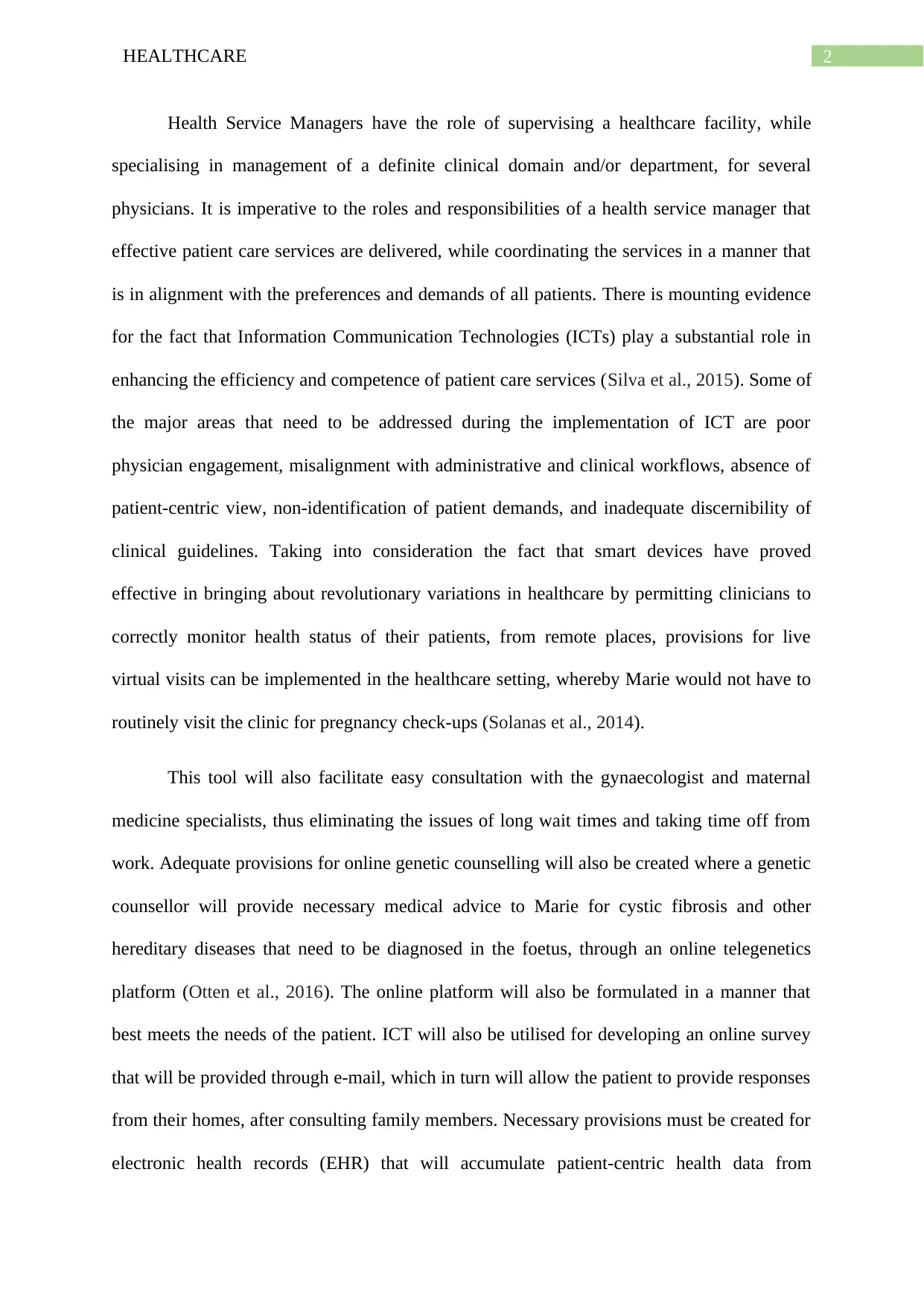
2HEALTHCARE
Health Service Managers have the role of supervising a healthcare facility, while
specialising in management of a definite clinical domain and/or department, for several
physicians. It is imperative to the roles and responsibilities of a health service manager that
effective patient care services are delivered, while coordinating the services in a manner that
is in alignment with the preferences and demands of all patients. There is mounting evidence
for the fact that Information Communication Technologies (ICTs) play a substantial role in
enhancing the efficiency and competence of patient care services (Silva et al., 2015). Some of
the major areas that need to be addressed during the implementation of ICT are poor
physician engagement, misalignment with administrative and clinical workflows, absence of
patient-centric view, non-identification of patient demands, and inadequate discernibility of
clinical guidelines. Taking into consideration the fact that smart devices have proved
effective in bringing about revolutionary variations in healthcare by permitting clinicians to
correctly monitor health status of their patients, from remote places, provisions for live
virtual visits can be implemented in the healthcare setting, whereby Marie would not have to
routinely visit the clinic for pregnancy check-ups (Solanas et al., 2014).
This tool will also facilitate easy consultation with the gynaecologist and maternal
medicine specialists, thus eliminating the issues of long wait times and taking time off from
work. Adequate provisions for online genetic counselling will also be created where a genetic
counsellor will provide necessary medical advice to Marie for cystic fibrosis and other
hereditary diseases that need to be diagnosed in the foetus, through an online telegenetics
platform (Otten et al., 2016). The online platform will also be formulated in a manner that
best meets the needs of the patient. ICT will also be utilised for developing an online survey
that will be provided through e-mail, which in turn will allow the patient to provide responses
from their homes, after consulting family members. Necessary provisions must be created for
electronic health records (EHR) that will accumulate patient-centric health data from
Health Service Managers have the role of supervising a healthcare facility, while
specialising in management of a definite clinical domain and/or department, for several
physicians. It is imperative to the roles and responsibilities of a health service manager that
effective patient care services are delivered, while coordinating the services in a manner that
is in alignment with the preferences and demands of all patients. There is mounting evidence
for the fact that Information Communication Technologies (ICTs) play a substantial role in
enhancing the efficiency and competence of patient care services (Silva et al., 2015). Some of
the major areas that need to be addressed during the implementation of ICT are poor
physician engagement, misalignment with administrative and clinical workflows, absence of
patient-centric view, non-identification of patient demands, and inadequate discernibility of
clinical guidelines. Taking into consideration the fact that smart devices have proved
effective in bringing about revolutionary variations in healthcare by permitting clinicians to
correctly monitor health status of their patients, from remote places, provisions for live
virtual visits can be implemented in the healthcare setting, whereby Marie would not have to
routinely visit the clinic for pregnancy check-ups (Solanas et al., 2014).
This tool will also facilitate easy consultation with the gynaecologist and maternal
medicine specialists, thus eliminating the issues of long wait times and taking time off from
work. Adequate provisions for online genetic counselling will also be created where a genetic
counsellor will provide necessary medical advice to Marie for cystic fibrosis and other
hereditary diseases that need to be diagnosed in the foetus, through an online telegenetics
platform (Otten et al., 2016). The online platform will also be formulated in a manner that
best meets the needs of the patient. ICT will also be utilised for developing an online survey
that will be provided through e-mail, which in turn will allow the patient to provide responses
from their homes, after consulting family members. Necessary provisions must be created for
electronic health records (EHR) that will accumulate patient-centric health data from
⊘ This is a preview!⊘
Do you want full access?
Subscribe today to unlock all pages.

Trusted by 1+ million students worldwide
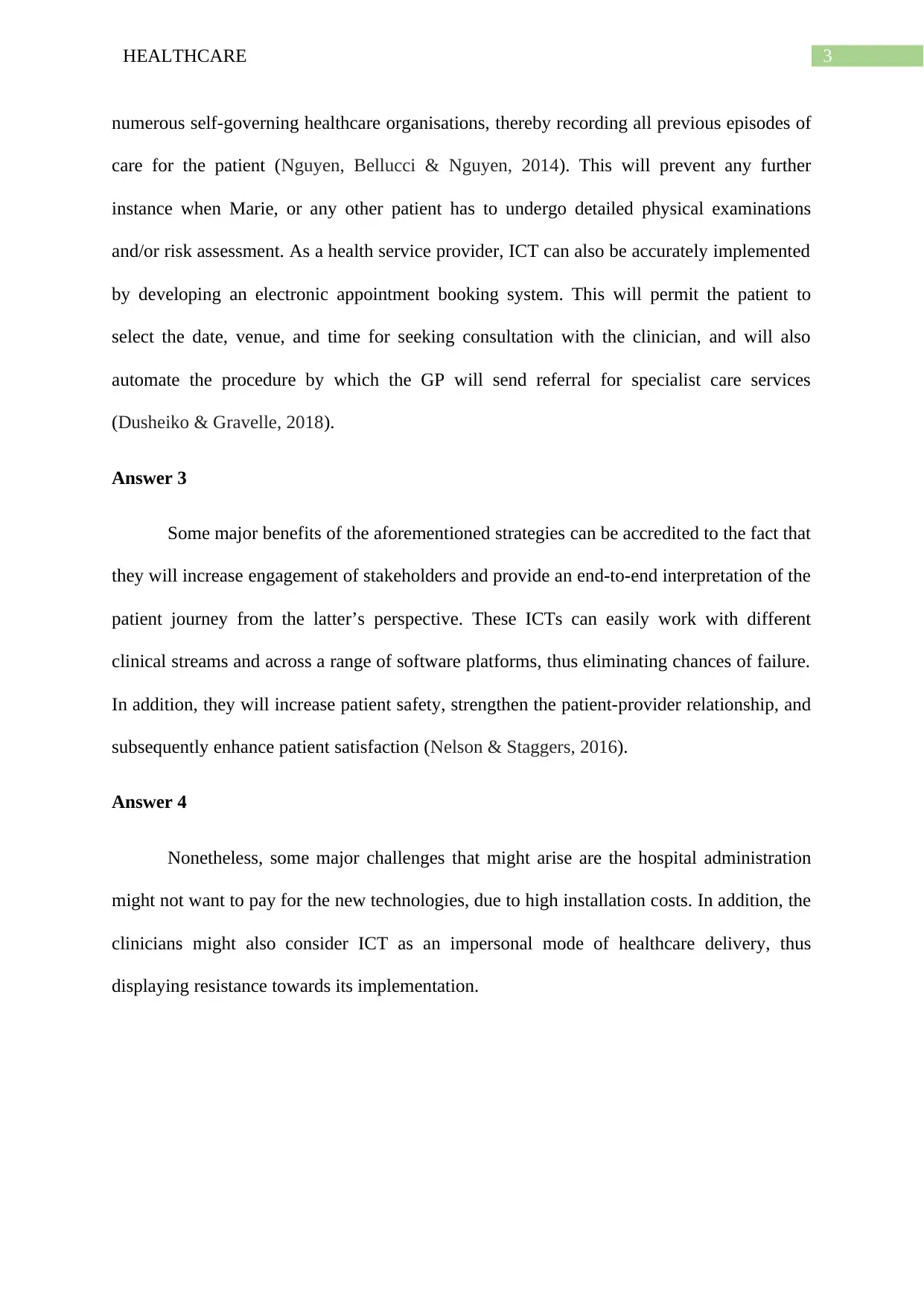
3HEALTHCARE
numerous self-governing healthcare organisations, thereby recording all previous episodes of
care for the patient (Nguyen, Bellucci & Nguyen, 2014). This will prevent any further
instance when Marie, or any other patient has to undergo detailed physical examinations
and/or risk assessment. As a health service provider, ICT can also be accurately implemented
by developing an electronic appointment booking system. This will permit the patient to
select the date, venue, and time for seeking consultation with the clinician, and will also
automate the procedure by which the GP will send referral for specialist care services
(Dusheiko & Gravelle, 2018).
Answer 3
Some major benefits of the aforementioned strategies can be accredited to the fact that
they will increase engagement of stakeholders and provide an end-to-end interpretation of the
patient journey from the latter’s perspective. These ICTs can easily work with different
clinical streams and across a range of software platforms, thus eliminating chances of failure.
In addition, they will increase patient safety, strengthen the patient-provider relationship, and
subsequently enhance patient satisfaction (Nelson & Staggers, 2016).
Answer 4
Nonetheless, some major challenges that might arise are the hospital administration
might not want to pay for the new technologies, due to high installation costs. In addition, the
clinicians might also consider ICT as an impersonal mode of healthcare delivery, thus
displaying resistance towards its implementation.
numerous self-governing healthcare organisations, thereby recording all previous episodes of
care for the patient (Nguyen, Bellucci & Nguyen, 2014). This will prevent any further
instance when Marie, or any other patient has to undergo detailed physical examinations
and/or risk assessment. As a health service provider, ICT can also be accurately implemented
by developing an electronic appointment booking system. This will permit the patient to
select the date, venue, and time for seeking consultation with the clinician, and will also
automate the procedure by which the GP will send referral for specialist care services
(Dusheiko & Gravelle, 2018).
Answer 3
Some major benefits of the aforementioned strategies can be accredited to the fact that
they will increase engagement of stakeholders and provide an end-to-end interpretation of the
patient journey from the latter’s perspective. These ICTs can easily work with different
clinical streams and across a range of software platforms, thus eliminating chances of failure.
In addition, they will increase patient safety, strengthen the patient-provider relationship, and
subsequently enhance patient satisfaction (Nelson & Staggers, 2016).
Answer 4
Nonetheless, some major challenges that might arise are the hospital administration
might not want to pay for the new technologies, due to high installation costs. In addition, the
clinicians might also consider ICT as an impersonal mode of healthcare delivery, thus
displaying resistance towards its implementation.
Paraphrase This Document
Need a fresh take? Get an instant paraphrase of this document with our AI Paraphraser
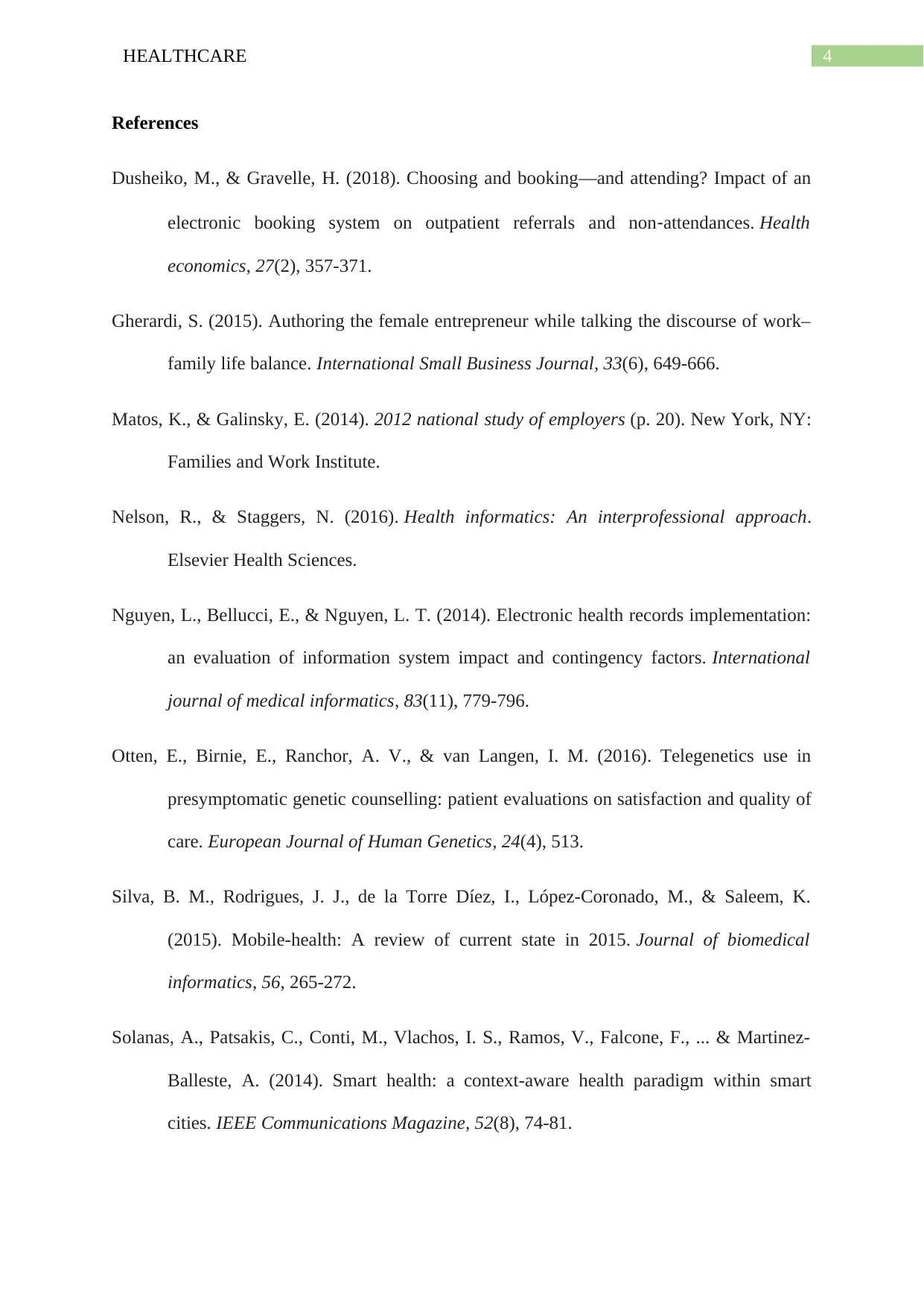
4HEALTHCARE
References
Dusheiko, M., & Gravelle, H. (2018). Choosing and booking—and attending? Impact of an
electronic booking system on outpatient referrals and non‐attendances. Health
economics, 27(2), 357-371.
Gherardi, S. (2015). Authoring the female entrepreneur while talking the discourse of work–
family life balance. International Small Business Journal, 33(6), 649-666.
Matos, K., & Galinsky, E. (2014). 2012 national study of employers (p. 20). New York, NY:
Families and Work Institute.
Nelson, R., & Staggers, N. (2016). Health informatics: An interprofessional approach.
Elsevier Health Sciences.
Nguyen, L., Bellucci, E., & Nguyen, L. T. (2014). Electronic health records implementation:
an evaluation of information system impact and contingency factors. International
journal of medical informatics, 83(11), 779-796.
Otten, E., Birnie, E., Ranchor, A. V., & van Langen, I. M. (2016). Telegenetics use in
presymptomatic genetic counselling: patient evaluations on satisfaction and quality of
care. European Journal of Human Genetics, 24(4), 513.
Silva, B. M., Rodrigues, J. J., de la Torre Díez, I., López-Coronado, M., & Saleem, K.
(2015). Mobile-health: A review of current state in 2015. Journal of biomedical
informatics, 56, 265-272.
Solanas, A., Patsakis, C., Conti, M., Vlachos, I. S., Ramos, V., Falcone, F., ... & Martinez-
Balleste, A. (2014). Smart health: a context-aware health paradigm within smart
cities. IEEE Communications Magazine, 52(8), 74-81.
References
Dusheiko, M., & Gravelle, H. (2018). Choosing and booking—and attending? Impact of an
electronic booking system on outpatient referrals and non‐attendances. Health
economics, 27(2), 357-371.
Gherardi, S. (2015). Authoring the female entrepreneur while talking the discourse of work–
family life balance. International Small Business Journal, 33(6), 649-666.
Matos, K., & Galinsky, E. (2014). 2012 national study of employers (p. 20). New York, NY:
Families and Work Institute.
Nelson, R., & Staggers, N. (2016). Health informatics: An interprofessional approach.
Elsevier Health Sciences.
Nguyen, L., Bellucci, E., & Nguyen, L. T. (2014). Electronic health records implementation:
an evaluation of information system impact and contingency factors. International
journal of medical informatics, 83(11), 779-796.
Otten, E., Birnie, E., Ranchor, A. V., & van Langen, I. M. (2016). Telegenetics use in
presymptomatic genetic counselling: patient evaluations on satisfaction and quality of
care. European Journal of Human Genetics, 24(4), 513.
Silva, B. M., Rodrigues, J. J., de la Torre Díez, I., López-Coronado, M., & Saleem, K.
(2015). Mobile-health: A review of current state in 2015. Journal of biomedical
informatics, 56, 265-272.
Solanas, A., Patsakis, C., Conti, M., Vlachos, I. S., Ramos, V., Falcone, F., ... & Martinez-
Balleste, A. (2014). Smart health: a context-aware health paradigm within smart
cities. IEEE Communications Magazine, 52(8), 74-81.
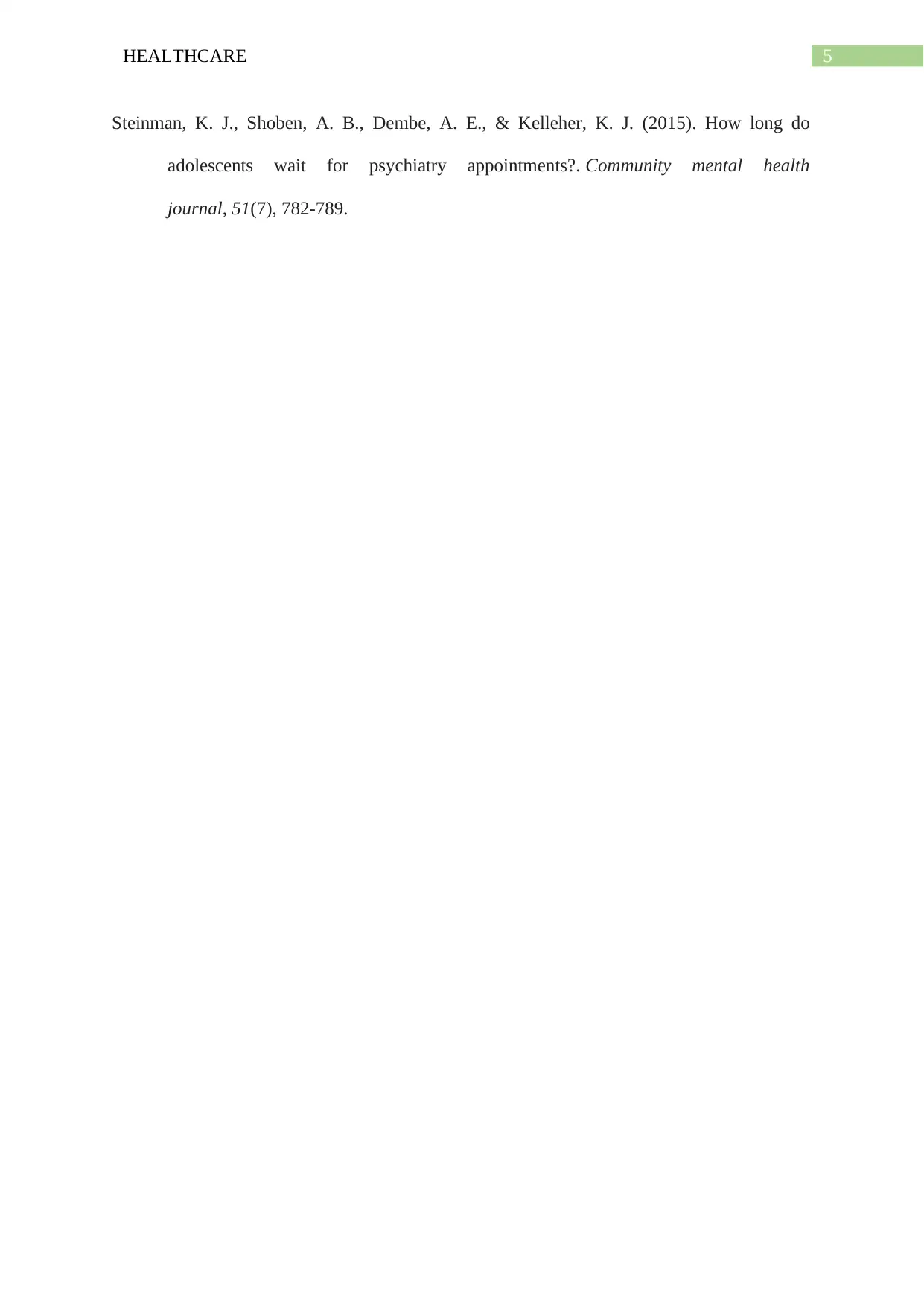
5HEALTHCARE
Steinman, K. J., Shoben, A. B., Dembe, A. E., & Kelleher, K. J. (2015). How long do
adolescents wait for psychiatry appointments?. Community mental health
journal, 51(7), 782-789.
Steinman, K. J., Shoben, A. B., Dembe, A. E., & Kelleher, K. J. (2015). How long do
adolescents wait for psychiatry appointments?. Community mental health
journal, 51(7), 782-789.
⊘ This is a preview!⊘
Do you want full access?
Subscribe today to unlock all pages.

Trusted by 1+ million students worldwide
1 out of 6
Related Documents
Your All-in-One AI-Powered Toolkit for Academic Success.
+13062052269
info@desklib.com
Available 24*7 on WhatsApp / Email
![[object Object]](/_next/static/media/star-bottom.7253800d.svg)
Unlock your academic potential
Copyright © 2020–2025 A2Z Services. All Rights Reserved. Developed and managed by ZUCOL.





